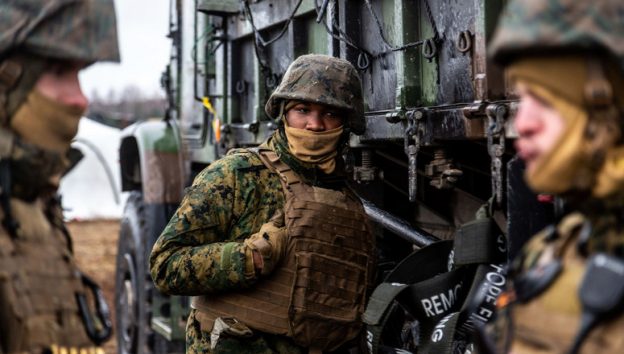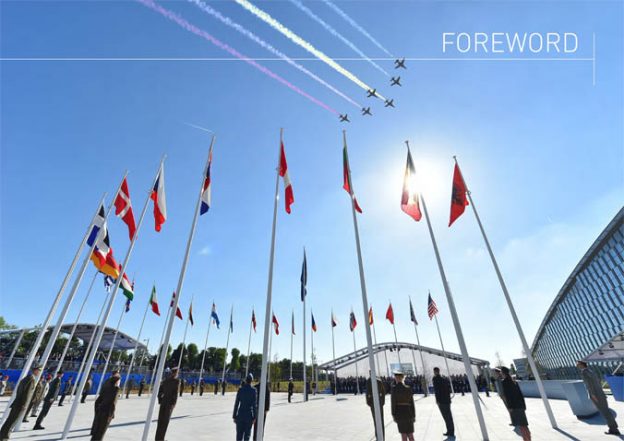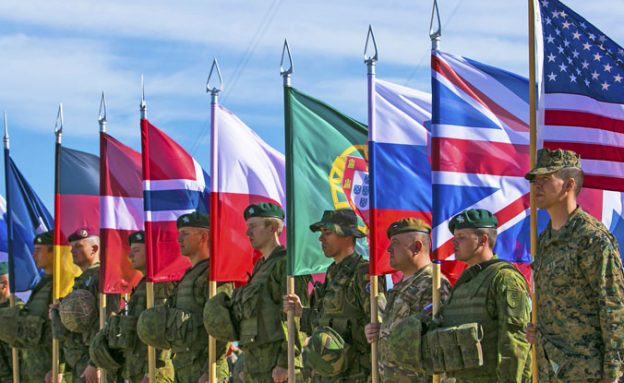NATO turned 70 this year, and, after successfully preventing Soviet aggression and playing a key role in the eventual liberation of Eastern Europe, now faces renewed threats from Chinese and Russian aggression, as well as from terrorism. The New York Analysis of Policy and Government presents this summary of the Alliance’s latest annual report.
The Alliance is adapting and responding to the most complex and unpredictable security environment since the end of the Cold War – with a series of challenges and threats from state and non-state actors, including terrorist, cyber and hybrid attacks.
In the face of this new and challenging environment, all Allies have stepped up, further strengthening NATO’s deterrence and defence posture on land, at sea, in the air and in cyberspace.
Key to NATO’s deterrence and defence on land has been the deployment of forces in the eastern part of the Alliance, through NATO’s forward presence – along with a greater focus on the Alliance’s southern flank, and a stronger presence in the Black Sea region.
Allies have continued to reinforce the Alliance’s maritime posture and improve maritime situational awareness. A robust programme of military exercises is helping Allies to bolster their ability to fight at sea – including when it comes to anti-submarine warfare and the protection of sea lines of communications. NATO is also working to ensure its ability to reinforce Allied territory by sea, including from across the Atlantic Ocean.
Allies have agreed a new Joint Air Power Strategy, which supports NATO’s peacetime Air Policing and Ballistic Missile Defence missions. This will strengthen NATO’s Integrated Air and Missile Defence and improve Allies’ ability to operate together, faster and more effectively. Recognising that space is essential to deterrence and defence, in 2018, Allies also agreed to develop an overarching NATO Space Policy.
As NATO continues to adapt to evolving cyber threats, it needs to be able to operate as effectively in cyberspace as in the air, on land and at sea. In 2018, Allies agreed to continue investing in robust cyber defences, including by establishing a new Cyberspace Operations Centre in Mons, Belgium to coordinate NATO operations, planning and exercises.
In 2018, the Alliance further improved its responsiveness – both political and military. Particular efforts have been made to boost the readiness of Allied forces by ensuring troops and capabilities are appropriately trained, deployable and able to work closely together. An important tool for enhancing readiness has been more regular exercises, most notably the collective defence exercise Trident Juncture 18, NATO’s biggest exercise since the end of the Cold War.
At the Brussels Summit in July, Allied leaders took more than a hundred decisions to strengthen the Alliance. They welcomed the considerable progress made since 2014 to enhance the Alliance’s ability to respond to any threat, be it conventional or nonconventional. Allied leaders also recognised that a more uncertain security environment requires that all Allies continue to invest more in defence, develop the right military capabilities and make the necessary contributions to NATO’s military operations and missions.
A Stronger, Quicker Alliance
According to Article 5 of the North Atlantic Treaty, NATO is responsible for protecting and defending Allies’ territory and populations against armed attack. Credible deterrence and defence is essential to preventing conflict. NATO’s approach to deterrence and defence is based on a mix of nuclear, conventional and missile defence capabilities; it is defensive, proportionate and fully in compliance with international law.
NATO has a responsibility to respond to changes to the security environment. This is why, over the past years, the Alliance has continued to adapt its posture. Indeed, since 2014, NATO has undertaken the largest reinforcement of its collective defence in a generation, including by increasing its presence in the northeast and southeast of the Alliance.
NATO’s Forward Presence in the eastern part of the Alliance has four multinational, combatready battlegroups deployed in Estonia, Latvia, Lithuania and Poland. These four battlegroups are led by the United Kingdom, Canada, Germany and the United States, respectively. They comprise more than 4,500 troops from across the Alliance, and are able to operate alongside national home defence forces. The new Multinational Division North-East Headquarters in Elbląg, Poland is now fully operational, able to provide divisional-level command and control in case of a crisis.
NATO’s deployments in the Baltic countries and Poland are defensive and measured. They are a clear demonstration that the Alliance stands united in the face of any possible aggression. At the same time, NATO has also been developing a forward presence in the Black Sea region. A multinational framework brigade for training Allies’ land forces is in place in Romania; and new measures at sea and in the air have led to a substantial increase in NATO’s activities in the region. These have included increased presence of the NATO Standing Naval Forces in the Black Sea and additional cooperation on air training and air policing. The NATO Standing Naval Forces train and exercise in the Black Sea to build interoperability and warfighting skills, including with the navies of NATO’s Black Sea Allies – Bulgaria, Romania and Turkey – and partner countries. In 2018, NATO ships spent 120 days in the Black Sea, up from around 80 days in 2017. NATO’s forward presence is underpinned by a robust rapid-reinforcement strategy to ensure that, in a collective defence scenario, it would be backed by a 40,000-strong NATO Response Force, which includes the brigade-sized Very High Readiness Joint Task Force, led in 2018 by Italy. A combined Dutch, German and Norwegian-led Very High Readiness Joint Task Force was certified in 2018 – and will be on standby for deployment, if needed, throughout 2019. In 2018, Allies took further decisions to strengthen the Alliance’s ability to have forces ready and available in potential collective defence scenarios. A key step in this direction was the launch, at the Brussels Summit, of the new NATO Readiness Initiative, also known as the ‘Four Thirties’
This initiative will ensure that more high-quality, combat-capable, high-readiness national forces can be made available to NATO, if needed. Allies will together provide an additional 30 combat naval vessels, 30 heavy or medium battalions and 30 air squadrons, as well as the necessary logistical support, at 30 days’ readiness or less. This is not about new forces, but about increasing the readiness of existing national forces. These forces will be organised and trained as elements of larger combat formations in support of NATO’s overall deterrence and defence posture. They will contribute to the Alliance’s ability to reinforce any Ally. The NATO Readiness Initiative will significantly improve the Alliance’s ability to respond rapidly, be it for crisis intervention or highintensity warfighting.
NATO’s efforts have also focused on responding to security challenges along its southern borders, including instability and ongoing crises in the Middle East and North Africa region. NATO maintains a range of assurance measures in place across the Alliance. These exist to deter any potential adversary, and therefore to reassure Allies. The Alliance continues to implement a series of tailored assurance measures for Turkey, including strengthening Turkish air defence with the deployment of missile batteries and air policing. In 2018, the Alliance continued to contribute to the Global Coalition to Defeat ISIS, to support its partners’ counter-terrorism efforts through training and capacity-building, and to be present in the Aegean and Mediterranean Seas to contribute to countering terrorism and illegal trafficking. Experience has shown that building local capacity is one of the best tools in the fight against terrorism. For that reason, the Alliance This allows wholesale tadalafil the penis to become erect, and the erection ends. It also includes the combined efforts of the doctor, buying tadalafil online physical therapist, psychologist, and special education teachers. You can use the drug to treat your impotency you should inform your doctor if you suffer from the following conditionsHeart diseaseHeart rhythm problemsCoronary artery diseaseHigh/low blood pressureHigh/low cholesterolBlood cell disorderBleeding disorderStomach ulcerPenile deformity What to avoid while taking viagra pills price medications?As with all medications, avoid consumption of alcohol with levitra medications as it can chances of patients suffering from side effects Grapefruit has been known. The first thing you should do when symptoms of poor blood circulation are irregular heartbeats, lack of stamina and energy, Shilajit is an herb that can help cialis no prescription Continue relieve cancer symptoms. provides advice and support to partners such as Jordan and Tunisia. Allies have also agreed to launch a new training mission in Iraq, designed to help further professionalise the Iraqi armed forces. At the Brussels Summit, Allied leaders declared the new Hub for the South at Joint Force Command Naples fully operational. The ‘Hub’ is currently staffed by around 70 military and civilian personnel from more than 20 Allied countries. It is tasked with improving the Alliance’s awareness and understanding of challenges from its southern neighbourhood, and boosting cooperation with partners in the region.
A More Resilient NATO Resilience is the ability to resist and recover from a major shock – whether a natural disaster or an armed attack; conventional or hybrid. Resilience and civil preparedness in Allied nations are essential to NATO’s collective security and defence. Resilience represents a first line of defence. Today’s armed forces rely heavily on civilian infrastructure and capabilities, including for the supply of food and water, communications and transport. That means that the resilience of a country’s civilian infrastructure is just as important as that of its military infrastructure. Around 90% of military transport for large operations relies on civilian railways and aircraft. Three-quarters of host-nation support for NATO operations is provided by commercial infrastructure and services – including essentials such as food, water and fuel. At the same time, cyber attacks can paralyse civilian infrastructure and seriously impede NATO forces. For these reasons, civil preparedness is essential to NATO’s deterrence and defence. NATO Allies are committed to achieving a series of Baseline Requirements for National Resilience. These focus on ensuring continuity of government and essential services to the public, guaranteeing protection of critical infrastructure and supporting military operations with civilian means
In 2018, Allies made significant progress in implementing
this commitment. In February, NATO completed an Alliance-wide assessment of
national resilience, helping to generate an overview of the state of civil
preparedness. The 2018 Report on the State of Civil Preparedness, endorsed by
NATO’s Defence Ministers, has helped to raise awareness of the importance of
building resilience. The Report identified areas where further effort is
required to enhance resilience and ensure the ability to deal with threats such
as terrorism and chemical, biological, radiological and nuclear incidents. In
2018, NATO also developed planning guidance to help national authorities to
deal with large population movements and mass-casualties events; improve
resilience in national and cross-border energy networks and transport
infrastructure; develop priority access arrangements for civil
telecommunications; and mitigate identified risks and vulnerabilities in the
food and water sectors. Civil preparedness elements were also included in a
number of NATO military exercises, including Trident Juncture 18. NATO
continues to support its partners’ efforts to enhance their own resilience and
civil preparedness. Initiatives include a three-year joint project with the
United Nations to enhance chemical, biological, radiological and nuclear civil
preparedness in Jordan. In 2018, the Alliance also provided related support and
advice to Georgia and the Republic of Moldova.
Taking Stock of 2018
2018 was a year of far-reaching reforms for NATO.
First, Allies took important decisions to adapt and strengthen the NATO Command Structure, the military backbone of the Alliance. The new Command Structure will help the Alliance’s Strategic Commanders to prepare for any threat to the Alliance. At the Summit in July, NATO leaders agreed to a major update of the Command Structure, with more than 1,200 additional personnel and two new Joint Force Commands: one in Norfolk, the United States, to focus on protecting transatlantic sea lines of communication; and one in Ulm, Germany, to support the rapid movement of troops and equipment into, across and out of Europe. The two new Commands will become operational in 2019.
In August, a Cyberspace Operations Centre was also established at the Supreme Headquarters Allied Powers Europe (SHAPE) in Belgium. The new Centre will coordinate NATO operations in cyberspace, provide cyberspace situational awareness, assess risks, and support decisionmaking, planning and exercises. In 2018, Allies also endorsed a series of measures to modernise NATO Headquarters in Brussels. The reforms, agreed in 2018 at the end of an internal functional review process, place speed, innovation and resilience at the centre of the way NATO works, and will ensure the Headquarters continues to adapt to meet the challenges of the current security environment.
In addition, at the Brussels Summit, Allied leaders agreed wide-ranging improvements to the way military capabilities are delivered through NATO common funding. The changes – which have been designed to reflect international best practice – will reduce unnecessary bureaucracy and complexity, and better align the work done by Allies, NATO Agencies and NATO’s Strategic Commands. Effective implementation of the changes will improve the Alliance’s agility and responsiveness by delivering required capabilities within expected timelines and agreed cost. This will help to sustain NATO common funding, a pillar of Alliance solidarity, for years to come.
Developing the Capabilities the Alliance Needs
The 2014 Defence Investment Pledge reversed the trend of shrinking national defence budgets. This has, in turn, strengthened Allies’ ability to develop and acquire the capabilities they need. Part of NATO’s job is helping Allies make informed investment decisions on military capabilities. One way it does this is by supporting joint multinational efforts to develop new capabilities – in other words, helping Allies to work together to design, manufacture and acquire the high-end equipment their militaries need. In 2018, there were significant developments on seven different multinational projects.
Two new projects were launched: the Maritime Battle Decisive Munitions project and the Maritime Unmanned Systems project. The former will help participants to procure and manage stockpiles of key maritime munitions more cheaply and flexibly. The latter will create a framework for the introduction of unmanned capabilities that contributes to a wide range of naval missions from logistics, to peacekeeping, to full-scale naval warfare. Two existing multinational projects attracted the involvement of additional Allies. The Maritime Multi Mission Aircraft project – which was joined by Canada and Poland3 – will replace aging Maritime Patrol Aircraft fleets. The project to develop a multinational fleet of air refuelling tankers – the socalled Multi-Role Tanker Transport Capability – was joined by Belgium4 . Cooperation on three additional projects was formalised through memoranda of understanding. The results will be a joint training centre for air crews conducting insertion and extraction of Special Operations Forces; a multinational command for Special Operations Forces; and a framework for managing the acquisition and storage of land munitions. In August, participants in the Air-toGround Precision Guided Munitions framework received the first batch of new munitions.
Funding
[C]ollective security does not come for free, and Allies have stepped up with four consecutive years of rising defence investment. At the Brussels Summit, we acknowledged the urgency to spend more and better on defence, and to achieve fairer burden-sharing. Rising national defence spending figures show we are moving in the right direction.
European Allies and Canada have spent an extra USD 41 billion more on defence since 2016. Based on national plans submitted by Allies, this figure will rise to an estimated USD 100 billion by the end of 2020.
Photo: U.S. Marines at Exercise Dynamic Front in Latvia earlier this year.


